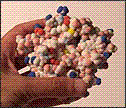Recombinant Protein
TF Trap
Other
| Cata #: | Name of Product: | Price: |
| hRP-0762 | Recombinant Human APG5L Protein | $300 |

Recombinant Human APG5L Protein
| Product Name: | Recombinant Human APG5L Protein |
| Catalog #: | hRP-0762 |
| Manufacture: | LD Biopharma, Inc. |
| Intruduction: | Autophagy is an evolutionarily conserved mechanism that plays important roles in both cell death and cell survival. Human ATG5 autophage related 5 homolog (S. cerevisiae) (ATG5L) is an essential constituent for autophagosome formation, which sequesters cytoplasmic materials before lysosomal delivery. Studying ATG5L function / regulation is very important for both cell death and survival in cancer development. Full-length human APG5L (275 aa) gene was constructed with 17aa N-terminal T7 tag and expressed in E.coli as inclusion bodies, refolded using our unique “temperature shift inclusion body refolding” technology and chromatographically purified. |
| Gene Symbol: | APG5L (APG5; ASP; hAPG5; APG5-like) |
| Accession Number: | NP_004840 |
| Species: | Human |
| Package Size: | 50 µg / Vial |
| Composition: | 1.0 mg/ml, sterile-filtered, in 20 mM pH 8.0 Tris-HCl Buffer, with proprietary formulation of NaCl, KCl, EDTA, Sucrose and DTT. |
| Storage: | In Liquid. Keep at -80°C for long term storage. Product is stable at 4 °C for at least 30 days. |
| Key Reference: | Lepine,S., et al.,Autophagy induced by deficiency of sphingosine-1-phosphate phosphohydrolase 1 is switched to apoptosis by calpain-mediated autophagy-related gene 5 (Atg5) cleavage. J. Biol. Chem. 286 (52), 44380-44390 (2011) Kim,M.S., et al., Expressional and mutational analyses of ATG5 gene in prostate cancers. APMIS 119 (11), 802-807 (2011) Lee,M.S., et al., Shiga toxins induce autophagy leading to differential signaling pathways in toxin-sensitive and toxin-resistant human cells. Cell. Microbiol. 13 (10), 1479-1496 (2011) |
| Applications: | 1. May be used for in vitro autophage / apoptosis regulation study with intracellular protein delivery of this protein. 2. As soluble/native protein, may be used as enzymatic substrate protein for ubiquitin assay. 3. May be used for mapping protein–protein interaction assay. 4. May be used as antigen for specific antibody development and cancer diagnostic development. |
| Quality Control: | Purity: > 90% by SDS-PAGE. |
| Recombinant Protein Sequence: | MASMTGGQQMGRGEFGSMTDDKDVLRDVWFGRIPTCFTLYQDEITEREAEPYYLLLPRVSYLTLVTDKVKKHFQKVMRQEDISEIWFEYEGTPLKWHYPIGLLFDLLASSSALPWNITVHFKSFPEKDLLHCPSKDAIEAHFMSCMKEADALKHKSQVINEMQKKDHKQLWMGLQNDRFDQFWAINRKLMEYPAEENGFRYIPFRIYQTTTERPFIQKLFRPVAADGQLHTLGDLLKEVCPSAIDPEDGEKKNQVMIHGIEPMLETPLQWLSEHLSYPDNFLHISIIPQPTD Download Datasheet |
